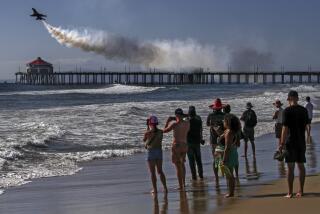FAA under pressure as clamor for small commercial drones grows
It seems like a perfect time to get into the drone business.
With easy access to technology and patchy regulation, small commercial drones already have been used to film box-office hits and market expensive real estate.
Internet retailer Amazon is testing its sixth generation of an unmanned aircraft system that could one day whisk packages to customers within hours. With big corporations like FedEx and Domino’s Pizza flirting with the technology, law firms, trade groups and insurers are lining up to capitalize on an expected economic gold mine.
There’s only one catch: Commercial drones are illegal.
In a 2007 policy statement, the Federal Aviation Administration essentially declared a ban on operating drones for commercial purposes. The agency doubled down on that position in early April, appealing an administrative order that tossed out the legal foundation for its policy. The ruling came after a commercial drone user challenged an FAA fine levied against him.
The ongoing case and mounting pressure to tap into the potentially lucrative industry puts the FAA in a tough spot. The regulatory body, responsible for keeping U.S. airspace safe, plans to propose a formal rule for commercial drones by the end of the year. But regulations aren’t likely to be finalized until 2015 at the earliest, leaving some wondering whether the FAA can catch up to an industry already half past go.
“I don’t think there’s any question that market pressure is intense and the FAA is struggling on the regulatory side to keep up,” said James H. Burnley, a former Transportation secretary and a Washington attorney.
Much of the commercial interest is focused on small drones — those that weigh less than 55 pounds, fly less than 400 feet high and often remain within the operator’s line of sight. Many look no different than toy helicopters.
But from a regulatory standpoint, integrating these drones into the national airspace is a complicated challenge that must reconcile evolving technology with safety concerns, including how to keep the drones from crashing into manned aircraft or causing damage or injury as they land.
“We really want to get it right the first time,” said FAA spokesman Les Dorr.
The FAA has certified more than 600 public-sector entities to fly drones, mostly law enforcement agencies and universities. It announced last month that the first of six national sites for commercial drone testing was ready in North Dakota.
But to date, the agency says it has made only one exception to its commercial ban, allowing oil company ConocoPhillips to survey marine mammals and ice in the Arctic.
Commercial drone advocates say the agency is taking too long. Thirty-three industry groups, including the National Ski Areas Assn. and National Sunflower Assn., are urging FAA Administrator Michael Huerta to expedite the approval process, citing a nearly four-year delay on its small-drone rule.
“The current regulatory void has left American entrepreneurs and others either sitting on the sidelines or operating in the absence of appropriate safety guidelines,” they wrote in an April 8 letter.
Some businesses aren’t waiting for the FAA rules to be completed. A Minnesota-based beer company made an online commercial that featured a drone transporting its “frosty winter lager” to some expectant ice fishermen.
Weeks later, a Detroit flower company announced plans to drone-deliver roses on Valentine’s Day. In March, the Washington Nationals sent up a drone to catch the baseball team’s spring training on tape.
Several large law firms have launched drone practices, and there’s even a fledgling insurance market. Nationwide Insurance’s agricultural subsidiary is offering liability coverage to a handful of customers who currently use small drones in their farm operations, an underwriting director confirmed.
Amazon told shareholders in April that it’s continuing to test the “octocopter” that it unveiled in December, saying it will be ready to roll out drone delivery service as soon as the FAA gives its OK.
Although even unauthorized testing of commercial drones is prohibited under the FAA policy and the agency regularly notifies operators when it discovers a violation, weak enforcement has often left businesses flying in an air of uncertainty. For many, the crime outweighs the punishment.
“If you wait until the FAA passes its rule, you will be too far behind,” said Jerry LeMieux, a retired Air Force colonel who serves as president of the Unmanned Vehicle University, an Arizona-based academy for unmanned systems engineering. “The time to get in is now.”
To date, the FAA has issued only one fine for an unauthorized commercial drone flight. It wrote a letter ordering the Minnesota beer company and the Detroit florist to cease their activities. But the agency learns about most violations only from reports in the media, tips from rival businesses or when companies film their drone flights and post them on YouTube.
“There is a perception, largely correct, that [operators] are unlikely to get caught, and if they do get caught, there aren’t going to be significant consequences,” said Timothy Reuter, a drone enthusiast in Washington, D.C., who created a network of local groups to highlight the benefits of civilian use.
Delays, many argue, have stymied an industry that could generate more than 70,000 jobs and $13.6 billion for the economy in its first three years, according to a forecast released last year by the Assn. for Unmanned Vehicle Systems International.
Hollywood has an especially rich history of using unmanned aircraft. In 1995, the company Flying-Cam took home an Oscar for developing an unmanned helicopter system equipped with a camera. Prior to the FAA ban, Flying-Cam shot more than 80 films in the U.S., according to its director of operations, Haik Gazarian.
Now it shoots advertisements and films (recent titles include “Skyfall” and “The Hangover”) on sets overseas, where commercial drone flight is often permitted. Likewise, Domino’s tested its drone in Britain.
Stoking hopes for faster action, an administrative law judge with the National Transportation Safety Board in March overruled the FAA’s only fine issued over a commercial drone flight. The $10,000 penalty was levied against Raphael Pirker, who was hired by a marketing company to capture aerial footage of the University of Virginia. The FAA said he flew the device “in a careless and reckless manner.”
The judge in the case, Patrick Geraghty, ruled that small commercial drones should, for legal purposes, be treated as model aircraft, which are governed by a set of self-enforced 1981 guidelines used by hobbyists without the need for FAA approval. Geraghty stayed the decision while the agency appeals to the full NTSB panel.
As the FAA defends its authority, it can expect to face additional legal obstacles. Pirker’s lawyer has filed a lawsuit challenging whether the agency ban can extend to a Texas nonprofit search-and-rescue firm. If higher courts also rule against the FAA, the decision could force the agency to explore other options for regulating the technology, said Rebecca MacPherson, a transportation lawyer and former FAA assistant chief counsel.
“If they lose this decision, they are really going to have to figure something out, because the current approach is not working,” she said.
More to Read
Sign up for Essential California
The most important California stories and recommendations in your inbox every morning.
You may occasionally receive promotional content from the Los Angeles Times.










